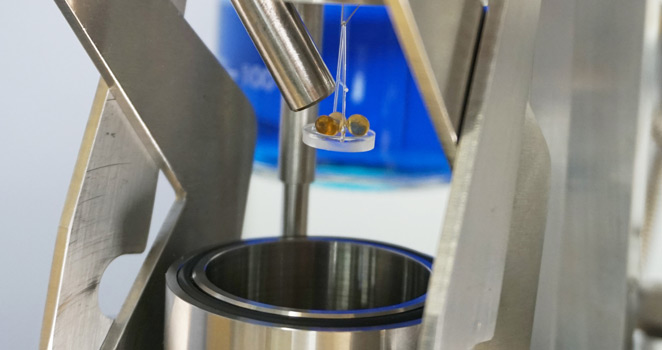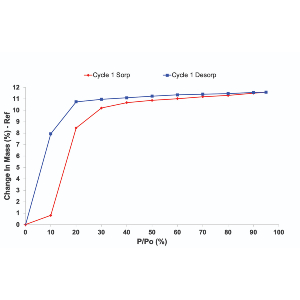
Sorption Overview Series #5
Comparing Sorption Methods
Comparing Sorption Methods
Lets talk measurement methods!
In this installment of our Sorption Overview series, we’re diving into the three most common methods used to measure gas or vapor uptake in materials: gravimetric, volumetric, and chromatographic (often referred to as breakthrough analysis).

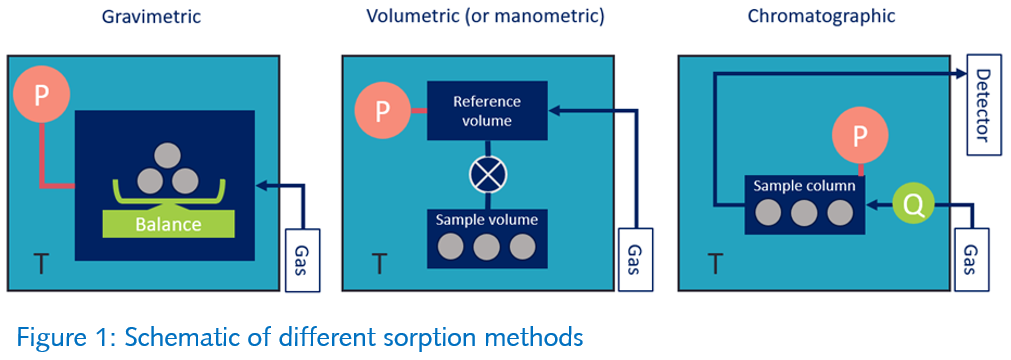

Gravimetric Method
Gravimetric techniques determine gas or vapor uptake by directly measuring changes in sample weight using a highly sensitive microbalance. As conditions such as temperature and pressure or vapor concentration change, the balance detects shifts in net force, which correspond to the amount of sorbate absorbed or adsorbed by the material.
Because they rely on precise weight measurements, gravimetric methods such as Dynamic Vapor Sorption (DVS) are considered among the most accurate techniques for sorption analysis. They are especially useful for studying a wide range of materials under controlled and variable environmental conditions.
| Sample Mass Uptake
In a standard experiment, the sample is loaded in the balance and isolated in a chamber. The chamber temperature is carefully monitored, alongside the pressure/concentration of the gas phase. Change in mass given by the balance has three contributions: the change in sample mass given by uptake in the sample, a change in net buoyant force given by the change in density of the gas phase and a drag force of a gas flow on the sample pan. Buoyancy Force The buoyancy force is small for experiments at ambient pressure and temperature but can play a role at high pressure (>a few bar) where corrections may be required. Drag Force The drag force is only relevant when a dynamic mode is used, as the gas flow impinges on the balance parts and may need to be corrected through a blank. A way of minimizing both drag and buoyancy corrections is to construct the balance symmetrically, having a sample and a reference pan in identical configurations in the flow path. Experimental Design
Advantages of Gravimetric Methods One of the key advantages of gravimetric sorption methods is their flexibility in sample size. For single-component measurements, as little as 1–5 mg of material is often sufficient to yield highly reliable results. At the same time, gravimetric systems can accommodate much larger sample sizes, handling several grams or tens of cubic centimeters, depending on the material and application. The accuracy and range of measurements are directly tied to the performance and stability of the microbalance. For example, Surface Measurement Systems (SMS) offers advanced gravimetric analyzers with exceptionally high resolution:
This combination of precision and versatility makes gravimetric methods ideal for both delicate, small-scale experiments and larger, industrially relevant studies. Challenges and Considerations While gravimetric sorption techniques are known for their high sensitivity and accuracy, there are a few practical considerations to keep in mind. Gravimetric systems typically require a stable laboratory environment, particularly with respect to temperature and vibration control, to ensure consistent results. Additionally, extended equilibration times may be needed for certain materials or conditions, especially when studying slow diffusion processes. |

Volumetric Method
In volumetric methods, a cell containing the adsorbent material is dosed sequentially from a known volume of gas. The pressure is monitored as the probe sorbs into the material, and the equilibrium pressure is then used to calculate the final amount of gas remaining in the cell using an equation of state. The difference between the initial and final amounts of gas is equal to the amount adsorbed.
Sample Uptake
Advantages of Volumetric Methods
Challenges and Considerations Volumetric sorption techniques rely on indirect measurement via pressure, which introduces several important limitations:
|

Chromatographic / Breakthrough Methods
In chromatographic methods, the probe molecule flows through a packed bed or column containing the material to be characterized. Key variables including temperature, total pressure or concentration, and flow rate are continuously monitored at both the inlet and outlet of the column. These measurements allow for the calculation of a molar mass balance across the packed bed, providing insight into the sorption behavior of the material under dynamic flow conditions.
| Method Modes Chromatographic and breakthrough methods are dynamic flow techniques used to study how probe molecules interact with packed columns. Most systems operate in a carrier mode for easier pressure control. Probe introduction typically happens in two ways:
Experimental Process A sample-packed column is weighed before and after preparation, with thermal activation applied if needed. The system’s dead volume is measured using a non-interacting gas pulse. The probe pulse or front passes through the column, and sensors measure outlet concentration and flow to determine uptake via mass balance. Challenges and Considerations Controlling temperature, pressure, concentration, and flow precisely makes this method complex. It requires larger sample amounts (hundreds of mg to grams) and can be scaled for industrial simulation. Sample form affects performance, as fine powders may cause blockages. Additional Capabilities These methods uniquely provide multicomponent adsorption data and insight into adsorption kinetics critical for scaling processes. Surface Measurement Systems offers the iGC-SEA and BTA Frontier analyzers as leading tools for these analyses.
|

Check back soon for the conclusion of the series!
Don’t forget to check out the Sorption Hub user portal for more eLearning resources in materials characterization!

Sorption Overview Series #5
Comparing Sorption Methods
Comparing Sorption Methods
Lets talk measurement methods!
In this installment of our Sorption Overview series, we’re diving into the three most common methods used to measure gas or vapor uptake in materials: gravimetric, volumetric, and chromatographic (often referred to as breakthrough analysis).


Gravimetric Method
Gravimetric techniques determine gas or vapor uptake by directly measuring changes in sample weight using a highly sensitive microbalance. As conditions such as temperature and pressure or vapor concentration change, the balance detects shifts in net force, which correspond to the amount of sorbate absorbed or adsorbed by the material.
Because they rely on precise weight measurements, gravimetric methods such as Dynamic Vapor Sorption (DVS) are considered among the most accurate techniques for sorption analysis. They are especially useful for studying a wide range of materials under controlled and variable environmental conditions.

Dynamic (Flowing)
In the dynamic method, a continuous flow of gas or vapor is passed over the sample. The method controls both the upstream rates of entry and the downstream exit rate, effectively controlling both the pressure/concentration and flow rate of the adsorbate in the chamber. It also helps to overcome some boundary layer diffusional barriers, by ensuring little to no concentration gradients around the sample. Both pure and carrier introduction is possible.
Note: The SMS DVS, SMS iGC-SEA and SMS BTA systems operate in dynamic mode, while the SMS DVS Vacuum can perform both static and dynamic introduction.

Check back soon for the conclusion of the series!
Don’t forget to check out the Sorption Hub user portal for more eLearning resources in materials characterization!

Sorption Overview Series #5
Comparing Sorption Methods
Comparing Sorption Methods
Lets talk measurement methods!
In this installment of our Sorption Overview series, we’re diving into the three most common methods used to measure gas or vapor uptake in materials: gravimetric, volumetric, and chromatographic (often referred to as breakthrough analysis).


Gravimetric Method
Gravimetric techniques determine gas or vapor uptake by directly measuring changes in sample weight using a highly sensitive microbalance. As conditions such as temperature and pressure or vapor concentration change, the balance detects shifts in net force, which correspond to the amount of sorbate absorbed or adsorbed by the material.
Because they rely on precise weight measurements, gravimetric methods such as Dynamic Vapor Sorption (DVS) are considered among the most accurate techniques for sorption analysis. They are especially useful for studying a wide range of materials under controlled and variable environmental conditions.
Do the results differ?
Interestingly, the number of probe molecules that interact with the material is the same in both methods. As illustrated in Figure 2, the equilibrium uptake is typically similar, regardless of the introduction method. However, the kinetics of sorption can vary, with carrier gas mode often offering a more accurate picture of how materials behave under practical conditions.
It’s important to note that for certain materials, even the choice of carrier gas may impact sorption behavior, so careful selection is essential.
Which Method Should You Use?
Both techniques are powerful tools in surface and materials science. The choice depends on your experimental goals:
- Choose pure mode when maximum control and absolute data are required.
- Opt for carrier mode when simulating realistic environments or studying sorption kinetics

Check back soon for the conclusion of the series!
Don’t forget to check out the Sorption Hub user portal for more eLearning resources in materials characterization!

Sorption Overview Series #5
Comparing Sorption Methods
Comparing Sorption Methods
Lets talk measurement methods!
In this installment of our Sorption Overview series, we’re diving into the three most common methods used to measure gas or vapor uptake in materials: gravimetric, volumetric, and chromatographic (often referred to as breakthrough analysis).

The Role of Temperature in SorptionThe average kinetic energy of all molecules in the system is unambiguously defined by temperature. Temperature is represented in Kelvin (K, the SI unit), degree Celsius (°C) or degree Fahrenheit (°F). Although measuring temperature accurately and ensuring its homogeneity throughout an instrument can be challenging, this discussion will focus on the relationship between temperature and kinetic energy. On the other hand, the number of target probe molecules which interact with the material at any point can be reported in a variety of ways, with terms such as pressure, absolute/partial pressure, relative pressure, humidity, water activity, volume/molar fraction and concentration, etc. The variety of terms will be discussed in more detail. |
Understanding Pressure and its VariantsAbsolute Pressure Total and Partial Pressure Fraction and Concentration One further complication is that the fraction can be either on a molar, volume, or mass basis of the components. The best way to represent the meaning of a fraction basis is through an example. In a balloon we put one mole of N2 and one mole of CO2. The molar fraction of N2 is 1/(1+1) = 0.5 in this mixture. To get the volume fraction, we must instead consider the volume contribution of each gas. If we consider both gases as ideal, a mole of each occupies 22.4 L, so for N2 the volume fraction is 22.4/(22.4+22.4) = 0.5. Finally for the mass fraction, we need to convert to weight by using the molar mass of each component, resulting in 28g of N2 and 44g of CO2. The mass fraction of N2 is then 28/(28+44) = 0.388. To differentiate between the three, we often use notation such as mol%, vol% and wt%. Sometimes fractions are also expressed as parts of a whole, e.g. parts-per-million or ppm. These can be converted into a regular fraction by dividing by the total number of parts. It is also important to refer to which basis these refer to, by using notation such as ppmv or ppmw, etc. These units are generally discouraged as they are confusing. Relative Pressure, Humidity and Water Activity |
|
| The formula for relative pressure is |
| Relative pressure is usually represented with the shorthand p/p0, ranging from 0 to 1, or from 0 to 100% if using a percent value. Humidity (RH) or water activity are both relative pressure terms, specifically used when the vapor is water. |

Critical Points and Relative Pressure
Above the critical point of a compound, there is no distinction between a liquid and gas state, which means that there is no vapor pressure. Such gases (for example N2 and CH4 at room temperature) cannot be represented in a relative pressure.
Figure 1 summarizes the different ways or reporting total pressure.

Check back soon for the conclusion of the series!
Don’t forget to check out the Sorption Hub user portal for more eLearning resources in materials characterization!

Sorption Overview Series #5
Comparing Sorption Methods
Comparing Sorption Methods
Lets talk measurement methods!
In this installment of our Sorption Overview series, we’re diving into the three most common methods used to measure gas or vapor uptake in materials: gravimetric, volumetric, and chromatographic (often referred to as breakthrough analysis).

The Role of Temperature in SorptionThe average kinetic energy of all molecules in the system is unambiguously defined by temperature. Temperature is represented in Kelvin (K, the SI unit), degree Celsius (°C) or degree Fahrenheit (°F). Although measuring temperature accurately and ensuring its homogeneity throughout an instrument can be challenging, this discussion will focus on the relationship between temperature and kinetic energy. On the other hand, the number of target probe molecules which interact with the material at any point can be reported in a variety of ways, with terms such as pressure, absolute/partial pressure, relative pressure, humidity, water activity, volume/molar fraction and concentration, etc. The variety of terms will be discussed in more detail. |

Check back soon for the conclusion of the series!
Don’t forget to check out the Sorption Hub user portal for more eLearning resources in materials characterization!

Unlocking Surface Energy Insights with the iGC-SEA Nova
iGC-SEA Nova Case Study
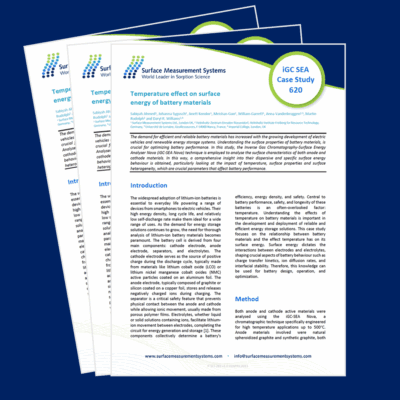

The 2024 Carbon Capture Innovation Prize Launches:
A New Research Competition
Singapore, April 2024 | Surface Measurement Systems is thrilled to announce the launch of the 2024 Carbon Capture Innovation Prize, a prestigious competition designed to accelerate research in the field of carbon capture technology. In a groundbreaking initiative alongside MOF2024, this challenge aims to support researchers seeking to revolutionize the way we employ materials to combat carbon emissions via carbon capture, and to highlight their pioneering research work. The final winner of this Prize will be awarded a DVS Carbon instrument valued at $150,000, a state-of-the-art scientific instrument that accurately measures CO2 uptake in materials under a range of real-world conditions.

| Fostering Innovation and Sustainability
As the world grapples with the escalating challenges of climate change, the need for innovative and sustainable solutions has never been more critical. The 2024 Carbon Capture Innovation Prize aims to harness the power of scientific ingenuity to develop new materials and technologies capable of capturing CO2 efficiently from atmospheric and industrial sources, thus contributing to a more carbon-neutral society. Surface Measurement Systems is committed to supporting global researchers who working on this important topic. About the Challenge Run in coordination with the world leading MOF2024, taking place 15 – 19 July 2024 in Singapore, this challenge invites professionals, academics, and innovators to submit a brief proposal on how a DVS Carbon would help their research ambitions. This state-of-the-art sorption analyzer is designed for precise measurement of CO2 capture in solid state materials across various test conditions. Competition entrants will submit a short research proposal on how they propose to employ this instrument to investigate new and exciting possibilities in materials for carbon capture. A panel of 5 international expert judges will evaluate the research proposals submitted to determine a final shortlist, and the winner. Eligibility and Awards The contest is open to professional researchers (no student applicants) affiliated with academic institutions, government laboratories, or startup companies. Entrants must have the authority to install the awarded instrument in their designated research area/laboratory. The winning submission will be awarded a DVS Carbon instrument, valued at over $150,000, to significantly bolster their research capabilities in discovering new materials for CO2 capture. The DVS Carbon The latest instrument in Surface Measurement Systems’ Dynamic Vapor Sorption series, the DVS Carbon sets a new industry benchmark for evaluating solid-state materials for CO2 capture. Capable of measuring uptake at a wide range of CO2 concentrations, temperatures, and in the presence of moisture, the DVS Carbon opens up exciting possibilities for predicting performance in new adsorbent materials for use in the CCUS space. This award aims to get the research community thinking about what they could achieve with this instrument, and provide a gateway for them to get supporting in achieving their goals. Submission Guidelines and Evaluation Criteria Proposals must be comprehensive, detailing the team’s background, research objectives, methodology, and the potential impact of their work on climate change solutions. Submissions will be evaluated based on innovation, scientific rigor, impact potential, and clarity. A panel of independent reviewers will select the winner and runners-up, with a preference for early career researchers in the event of a competition tie. An application form is available here Recognition and Collaboration The winner and four runners-up will be showcased at an official ceremony during MOF2024 conference , gaining substantial exposure among leading researchers. Additionally, the winner will have the opportunity to share their findings in future webinars hosted by Surface Measurement Systems, fostering collaboration and knowledge exchange within the scientific community. Join the Movement Towards a Carbon-Neutral Future Surface Measurement Systems invites global researchers to partake in this unique opportunity to contribute to a more sustainable future, and secure a hugely valuable research tool for developing advanced material solutions. The deadline for submissions is June 17th, 2024, with the winner to be announced during the MOF2024 conference. For more information on the Carbon Capture Innovation Challenge and how to submit your proposal, please visit www.sorptionhub.com/mof24-cc-prize |

About Surface Measurement Systems
Surface Measurement Systems is at the forefront of developing innovative technologies for material science. Specializing in advanced analytical instruments, the company is dedicated to supporting research that addresses some of the most pressing environmental challenges of our time.
Join us in shaping the future of carbon capture technology and making a tangible impact on reducing global warming.

Unlocking Surface Energy Insights with the iGC-SEA Nova
iGC-SEA Nova Case Study


Unlocking Breakthroughs:
8 Ways DVS is Essential to
Pharmaceutical Research
Moisture sorption properties stand at the forefront of pharmaceutical material considerations, exerting profound effects on storage, stability, processing, and performance. Guided by the stringent standards of regulators around the world, moisture, far from being a mere impurity, commands strict monitoring and control, especially within drug substances.
The implications of moisture content extend across critical facets of pharmaceutical products, influencing crystallinity, storage modulus, permeability, density, and the melting point, with a pronounced impact on amorphous materials. Recognizing the need for a nuanced approach to moisture analysis, the Dynamic Vapor Sorption (DVS) technique was developed by Surface Measurement Systems in the early 1990s.
This technique, now a cornerstone in pharmaceutical research, offers a rapid, highly-sensitive, and automated method for studying moisture sorption properties across a spectrum of materials. Below we unravel the multifaceted benefits of employing DVS in the analysis of pharmaceutical materials.


1. Compliance with pharmaceutical regulations
The Dynamic Vapour Sorption (DVS) technique is instrumental in meeting stringent US pharmaceutical standards by providing a rapid, highly sensitive, and continuous approach to studying moisture sorption properties. Developed by Surface Measurement Systems, the DVS instrument ensures compliance with US Pharmacopeia guidelines by actively measuring and controlling relative humidity and a wide range of organic vapour concentrations. This precision in environmental control enhances understanding across various applications, including the determination of moisture content, sorption isotherms, and the characterization of hydrates and solvates. Additionally, DVS proves valuable in assessing hygroscopicity, a crucial factor in preformulation activities and the selection of drug crystal forms.

2. Provides unparalleled insight into moisture-induced phase changes
Understanding moisture-induced phase changes is vital in the development of pharmaceutical materials, with a focus on crystallinity, amorphous substances, and hydrate and solvate formation. DVS enables precise examination of amorphous solids, crucial for understanding the critical humidity at which glass transitions occur, impacting storage and processing conditions. Linear relative humidity ramping experiments and 2-dimensional phase diagrams contribute to determining optimal stability conditions for amorphous pharmaceutical ingredients.
Furthermore, DVS plays a vital role in characterizing hydrate and solvate formation, offering valuable data for pharmaceutical development. It detects different hydrate forms and studies stoichiometric solvates, providing a versatile methodology for various solvent concentrations. The integration of DVS with in-situ vibrational spectroscopy enhances the understanding of moisture-induced phase changes by monitoring molecular vibrational characteristics. In summary, DVS is an indispensable tool for unravelling the complexities of moisture-induced phase changes in pharmaceuticals, encompassing crystallinity, amorphous materials, and hydrate and solvate formation.

3. Understand the moisture sorption hysteresis of your materials
When attempting to analyse moisture sorption hysteresis, the DVS technique has a unique ability to swiftly measure sorption kinetics and determine moisture diffusion coefficients, facilitating a comprehensive understanding of material transformations. This rapid and continuous measurement capability is in stark contrast to the prolonged timelines associated with traditional desiccator jar methods. DVS’s role extends beyond the laboratory, offering insights into formulation optimization, manufacturing, and quality control processes. By studying moisture sorption hysteresis, researchers can make informed decisions about storage requirements, ensuring the stability and performance of pharmaceutical materials. The instrument’s simultaneous determination of sorption and desorption isotherms on the same sample is particularly valuable, shedding light on dynamic material behaviour under varying humidity conditions. This nuanced understanding aids in tailoring formulations for optimal performance, ultimately contributing to the efficiency and quality of pharmaceutical production.

4. More than just powders – gain vital insight on pharma packaging materials
Dynamic Vapour Sorption (DVS) emerges as an indispensable tool in pharmaceutical research, particularly in the realm of studying packaging materials. DVS facilitates the measurement of diffusion coefficients for films, powders, and fibers, providing valuable insights into the permeability and transport properties of pharmaceutical packaging materials. By conducting real-time mass change experiments, DVS allows for the determination of diffusion coefficients over a range of temperatures, offering a nuanced understanding of how these materials interact with water vapor. This capability is particularly beneficial for packaging applications, where the diffusion into films can be critical for ensuring the stability and integrity of pharmaceutical products during storage and transportation.
Furthermore, DVS proves instrumental in evaluating water vapor transmission rates (WVTR) for pharmaceutical packaging materials. The innovative Payne style diffusion cell, designed for this purpose, enables the measurement of the rate of diffusion of water vapor through thin films. This information is crucial for assessing the effectiveness of packaging barriers in preventing moisture ingress, which is vital for maintaining the quality and shelf-life of pharmaceutical products. The combination of diffusion coefficient determination and WVTR measurement using DVS provides comprehensive data for optimizing pharmaceutical packaging, contributing to the development of packaging solutions that meet stringent quality standards and regulatory requirements.

5. Gain detail insight into sorption mechanisms of pharma materials
Having a detailed understanding of the sorption mechanisms of any given material is essential in determining the effective use of pharmaceutical materials, including excipients, drug formulations, and packaging films. One significant benefit of DVS is its ability to generate moisture sorption isotherms, providing crucial insights into the material’s response to varying relative humidity (RH) levels. Unlike traditional methods such as the desiccator jar, DVS enables continuous measurement of sorption kinetics, allowing for the determination of moisture diffusion coefficients and the measurement of sorption and desorption isotherms on the same sample. This real-time capability significantly accelerates the process, reducing the time required for determining isotherms from weeks or months to hours or days. Additionally, DVS facilitates the measurement of moisture-induced phase changes, aiding in the understanding of critical humidity thresholds for glass transitions and potential issues such as powder caking.
As previously mentioned, the DVS technique proves instrumental in characterizing hydrates and solvates of pharmaceutical materials. It enables the detection and characterization of hydrate formation based on environmental relative humidity, allowing for a deeper understanding of the influence of hydration states on physico-chemical properties. DVS can also extend its applicability to studying stoichiometric solvates, providing valuable information on solvate formation and stability. The technique’s combination with in-situ vibrational spectroscopy enhances its capabilities, allowing for the monitoring of molecular vibrational characteristics during hydration state changes. Overall, DVS emerges as a powerful tool for predicting dispersion in liquid solvents, offering insights into sorption kinetics, isotherm characteristics, and the formation of hydrates and solvates critical for pharmaceutical development and quality control.

6. Understand the importance of sorption and desorption curves with continuous measurement of sorption kinetics
Crucial insights into moisture sorption properties through the analysis of sorption and desorption isotherms are vital to ensuring stability in materials for new coatings and treatments. By continuously measuring sorption kinetics in real-time, DVS enables the determination of moisture diffusion coefficients and the exploration of moisture sorption hysteresis on the same sample. This dynamic approach accelerates data collection, offering a nuanced understanding of how pharmaceutical materials interact with water vapor at various relative humidity levels, essential for assessing storage conditions and preventing potential degradation risks.
Sorption kinetics data obtained from DVS play a pivotal role in developing coatings and treatments aimed at maintaining product stability. Understanding the rate of moisture absorption and release empowers researchers to design precise coatings, preventing moisture-induced phase changes that could compromise the stability of amorphous pharmaceutical ingredients. DVS’s real-time, detailed sorption kinetics data facilitate the customization of coatings and treatments, ensuring materials withstand environmental humidity, contributing to the formulation of pharmaceutical products that meet stringent stability and quality requirements throughout their lifecycle.

7. Impact of moisture in Hydrolysis and Drug Degradation
Crucial insights into moisture sorption properties through the analysis of sorption and desorption isotherms are vital to ensuring stability in materials for new coatings and treatments. By continuously measuring sorption kinetics in real-time, DVS enables the determination of moisture diffusion coefficients and the exploration of moisture sorption hysteresis on the same sample. This dynamic approach accelerates data collection, offering a nuanced understanding of how pharmaceutical materials interact with water vapor at various relative humidity levels, essential for assessing storage conditions and preventing potential degradation risks.
Sorption kinetics data obtained from DVS play a pivotal role in developing coatings and treatments aimed at maintaining product stability. Understanding the rate of moisture absorption and release empowers researchers to design precise coatings, preventing moisture-induced phase changes that could compromise the stability of amorphous pharmaceutical ingredients. DVS’s real-time, detailed sorption kinetics data facilitate the customization of coatings and treatments, ensuring materials withstand environmental humidity, contributing to the formulation of pharmaceutical products that meet stringent stability and quality requirements throughout their lifecycle.

8. Unlock advanced applications with organic solvents sorption analysis
When applied with organic solvents, the Dynamic Vapour Sorption (DVS) technique unlocks advanced applications that significantly contribute to characterizing and determining physicochemical properties, particularly surface area, in pharmaceutical materials. DVS instruments, with their unique capability to actively measure and control the concentration of a broad range of organic vapours, extends its utility beyond water vapour analysis. This innovative feature allows researchers to explore the interaction between pharmaceutical materials and organic solvents in real time. Notably, the DVS technique applied to organic solvents proves instrumental in determining surface area using the BET (Brunauer-Emmett-Teller) method. Unlike traditional volumetric techniques, DVS experiments are performed at atmospheric pressure and room temperature, mitigating the risk of altering the fragile structure of materials.
The application of DVS with organic solvents is exemplified in the determination of the BET surface area for pharmaceutical materials, such as Metformin Hydrochloride, showcasing the technique’s advantages over conventional methods. The dynamic flow nature of DVS enables rapid equilibration, providing efficient and accurate measurements of surface area with relatively small sample sizes. This capability is particularly advantageous for new drug entities or materials with very low surface areas. Therefore, the DVS technique, when coupled with organic solvents, emerges as a powerful tool for pharmaceutical researchers, offering a dynamic and precise approach to surface area determination and advancing the characterization of materials critical for drug development and quality control.
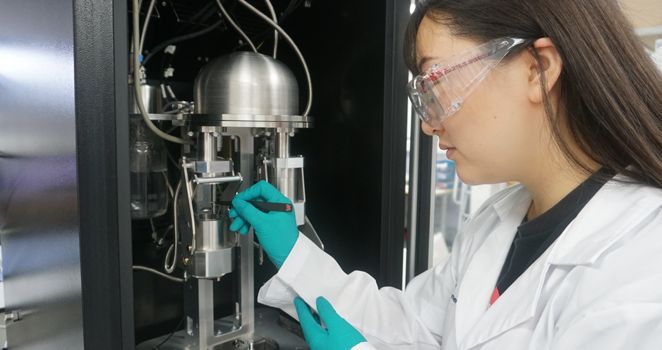
Conclusion:
In conclusion, the Dynamic Vapour Sorption (DVS) technique presented here demonstrates its pivotal role in unraveling the complexities of moisture sorption, hydrate/solvate formation, and physicochemical properties in pharmaceutical materials. Its wide range of applications, from understanding moisture-induced phase changes to characterizing surface area with organic solvents, showcases the versatility and precision of DVS technology.
For those seeking to delve deeper into these advanced applications and explore the full potential of our DVS, find out more about our products on our company page, or read a full Pharma Overview Scientific Note for DVS using the link below.

Unlocking Surface Energy Insights with the iGC-SEA Nova
iGC-SEA Nova Case Study

